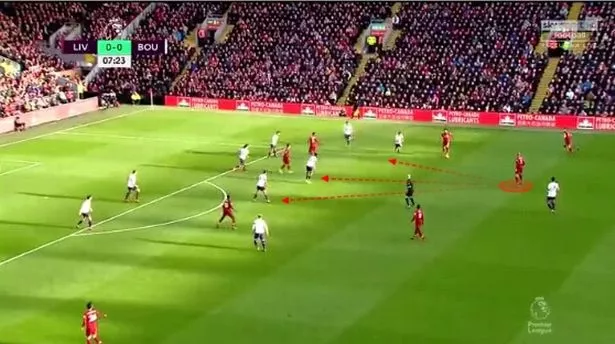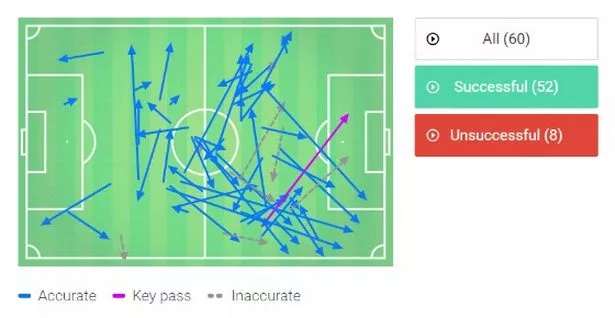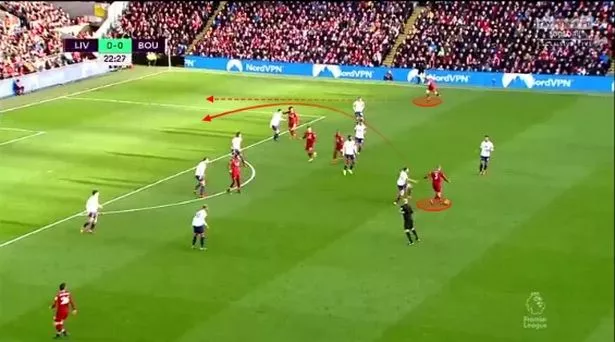From the Echo:
How Fabinho has become Europe's finest defensive midfielder - making Manchester United and Chelsea look foolish

In the summer transfer window, the fashionable signing amongst the top clubs in the Premier League seemed to be the ‘defensive midfielder’. Chelsea signed Jorginho, Manchester United bought Fred, Arsenal purchased Lucas Torriera - and all three of these players made an appearance on the opening weekend of the season for their new clubs.
Liverpool, however, signed Fabinho; interestingly, he didn't start a single Premier League match until October 20, by which point Jorginho had played every minute, Fred had made three starts, and Torriera had also started three. The narrative at this stage was that Fabinho was the one transfer mistake of the quartet, because he seemingly couldn't break into Liverpool's squad, never mind the starting 11.
Presently though, perhaps only Torriera's reputation remains intact enough to rival Fabinho's.
The criticism surrounding Jorginho has gradually progressed with time, as he's now essentially shouldering a lot of the blame for the renowned 'Sarriball' supposedly faltering; Fred fell out of favour pretty quickly at United after failing to impress, and he consequently hasn't made a single league appearance since Boxing Day.
In terms of Fabinho though, he's been quite the opposite and has instead progressed and improved steadily, after being cautiously eased into match situations by Jurgen Klopp.
Liverpool's offensively fluid system under Klopp is effective and delivers results due to its solid foundations and underlying organisation. The team regularly appear free-flowing, but there's a method behind the madness. Before Fabinho could contribute effectively by making starts, he had to have these methods ingrained into his game, and his discipline is now being showcased consistently. The Brazilian now has Liverpool's patterns of play embedded into his behaviour on the pitch, but crucially, he's combined those patterns with his natural aggressive tendencies.
In doing so, Fabinho has moulded himself into a unique type of midfielder that's highly useful to Klopp, especially when facing inferior opponents at Anfield. This was particularly evident in the recent 3-0 win over Bournemouth. Against these types of teams at Anfield, the Reds look to dominate the play, assert their authority and keep the opposing team penned in by probing in the final third. In order to sustain such attacks though, any immediate counters that are initiated by the opposition have to be prevented before they materialise.
This is where Fabinho excels, as he's one of Europe's best midfielders when required to defend proactively. Speaking to The Anfield Wrap recently, Goal’s Liverpool correspondent - and former ECHO scribe - Neil Jones stated that during a chat with Anfield assistant boss Pep Ljinders, the coach declared that Fabinho is “elite when defending forwards”.
Below, is an example of the type of position that Fabinho frequently takes, particularly against weaker sides:

Fabinho is positioned high up the pitch against Bournemouth (Image: WyScout)
Operating in such an area allows Fabinho to have immediate access to potential counter-attacks that ensue within his vicinity. He’s consequently able to assess the problem quickly, before timing his tackles perfectly to allow his team to restart their attack, as shown below. Fabinho averages more interceptions in the final third per 90 minutes than any other Liverpool player, and below is a graphic of his passes from the victory over Eddie Howe’s side, with the Reds attacking from left to right.

Fabinho's passes are concentrated in Bournemouth's final third (Image: WyScout)
Notably, despite being signed as a ‘defensive midfielder’, Fabinho evidently completed a large number of his passes in the final third of the pitch. He’s able to play in these advanced areas because he’s composed and technical enough to play in tight spaces, but also because as previously stated, he’s able to extinguish sudden fires very efficiently. He has become Liverpool's on-field tactical firefighter.
Another example is provided in the graphic below, with Fabinho again patrolling on the edge of the final third and contributing both offensively and defensively as a result. In the moment, the Brazilian international received a pass and rather than playing simple, he lifted the ball diagonally over the opposing defence for James Milner to run onto.

Fabinho finds James Milner out wide (Image: WyScout)
If however, the ball was lost, Fabinho’s position would’ve allowed him to again swiftly prevent the counter-attack before it even began. Overall, despite being eased in slower than his competitors, Fabinho is now productively contributing to Liverpool by combining his own skills with the patterns that have been fashioned into his game.
Consequently, Fabinho has become significantly effective against the teams that Liverpool wish to dominate for large periods. The South American offers a patrolling influence in the final third, by offering a technical spark - as well as a forcefulness without the ball.
How Fabinho has become Europe's finest defensive midfielder - making Manchester United and Chelsea look foolish

In the summer transfer window, the fashionable signing amongst the top clubs in the Premier League seemed to be the ‘defensive midfielder’. Chelsea signed Jorginho, Manchester United bought Fred, Arsenal purchased Lucas Torriera - and all three of these players made an appearance on the opening weekend of the season for their new clubs.
Liverpool, however, signed Fabinho; interestingly, he didn't start a single Premier League match until October 20, by which point Jorginho had played every minute, Fred had made three starts, and Torriera had also started three. The narrative at this stage was that Fabinho was the one transfer mistake of the quartet, because he seemingly couldn't break into Liverpool's squad, never mind the starting 11.
Presently though, perhaps only Torriera's reputation remains intact enough to rival Fabinho's.
The criticism surrounding Jorginho has gradually progressed with time, as he's now essentially shouldering a lot of the blame for the renowned 'Sarriball' supposedly faltering; Fred fell out of favour pretty quickly at United after failing to impress, and he consequently hasn't made a single league appearance since Boxing Day.
In terms of Fabinho though, he's been quite the opposite and has instead progressed and improved steadily, after being cautiously eased into match situations by Jurgen Klopp.
Liverpool's offensively fluid system under Klopp is effective and delivers results due to its solid foundations and underlying organisation. The team regularly appear free-flowing, but there's a method behind the madness. Before Fabinho could contribute effectively by making starts, he had to have these methods ingrained into his game, and his discipline is now being showcased consistently. The Brazilian now has Liverpool's patterns of play embedded into his behaviour on the pitch, but crucially, he's combined those patterns with his natural aggressive tendencies.
In doing so, Fabinho has moulded himself into a unique type of midfielder that's highly useful to Klopp, especially when facing inferior opponents at Anfield. This was particularly evident in the recent 3-0 win over Bournemouth. Against these types of teams at Anfield, the Reds look to dominate the play, assert their authority and keep the opposing team penned in by probing in the final third. In order to sustain such attacks though, any immediate counters that are initiated by the opposition have to be prevented before they materialise.
This is where Fabinho excels, as he's one of Europe's best midfielders when required to defend proactively. Speaking to The Anfield Wrap recently, Goal’s Liverpool correspondent - and former ECHO scribe - Neil Jones stated that during a chat with Anfield assistant boss Pep Ljinders, the coach declared that Fabinho is “elite when defending forwards”.
Below, is an example of the type of position that Fabinho frequently takes, particularly against weaker sides:

Fabinho is positioned high up the pitch against Bournemouth (Image: WyScout)
Operating in such an area allows Fabinho to have immediate access to potential counter-attacks that ensue within his vicinity. He’s consequently able to assess the problem quickly, before timing his tackles perfectly to allow his team to restart their attack, as shown below. Fabinho averages more interceptions in the final third per 90 minutes than any other Liverpool player, and below is a graphic of his passes from the victory over Eddie Howe’s side, with the Reds attacking from left to right.

Fabinho's passes are concentrated in Bournemouth's final third (Image: WyScout)
Notably, despite being signed as a ‘defensive midfielder’, Fabinho evidently completed a large number of his passes in the final third of the pitch. He’s able to play in these advanced areas because he’s composed and technical enough to play in tight spaces, but also because as previously stated, he’s able to extinguish sudden fires very efficiently. He has become Liverpool's on-field tactical firefighter.
Another example is provided in the graphic below, with Fabinho again patrolling on the edge of the final third and contributing both offensively and defensively as a result. In the moment, the Brazilian international received a pass and rather than playing simple, he lifted the ball diagonally over the opposing defence for James Milner to run onto.

Fabinho finds James Milner out wide (Image: WyScout)
If however, the ball was lost, Fabinho’s position would’ve allowed him to again swiftly prevent the counter-attack before it even began. Overall, despite being eased in slower than his competitors, Fabinho is now productively contributing to Liverpool by combining his own skills with the patterns that have been fashioned into his game.
Consequently, Fabinho has become significantly effective against the teams that Liverpool wish to dominate for large periods. The South American offers a patrolling influence in the final third, by offering a technical spark - as well as a forcefulness without the ball.


